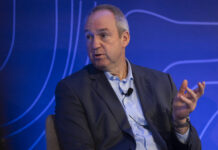
[miningmx.com] – ONE of the more amusing aspects of the gold industry is the sheer astonishment expressed by its leaders whenever the metal faulters, whereas with other metals, such as iron ore, copper or even gold’s precious metal counterpart, platinum, there’s a high degree of market visibility.
Not so in gold.
So it was that in his seminal presentation to the Melbourne Mining Club in 2012, Nick Holland, CEO of South Africa’s Gold Fields was still able to confidently predict a bright future for the price of gold which he said was fundamentally strong.
The rising popularity of gold-backed exchange traded products, net gold purchases by central banks, strong demand for physical gold in India and China, and the fact that only 1% of the investment world was invested in gold (which means there’s always a place for it regardless) were the factors that would support gold in its bull run, said Holland.
This was the presentation in which Holland presciently decried the gold industry’s futile pursuit of production scale over profitability, a practice in the industry which was losing it the faith of investors.
How is it possible that the gold market could turn so savagely against Holland and his peers only eight months later?
Holland acknowledges gold’s price behaviour has been surprising, but he isn’t negative on it. “What has changed in the gold market? The stimulus has still not kicked the US market into a clear recovery, India remains a major buyer of physical metal, and Euroland is still in a mess,’ said Holland in an interview.
He also thinks the liquidation of gold-backed exchange traded products earlier this year may have affected sentiment to gold, but in reality ETNs are a small part of the gold industry.
Srinivasan Venkatakrishnan, CEO of AngloGold Ashanti, thinks it’s the fact gold represents so many different forms of value to different groups: a hedge against inflation to some, a backstop to economic and political disaster for others; for yet others, a currency; a form of jewellery, or a store of long-term wealth.
“Any adjustment in one of those things can push changes in the other elements,’ says Venkat.
The heavy decline in the gold price this year, however, still came as a surprise. “Hand on heart, I didn’t think the gold price would lose a quarter of its value so quickly,’ he says.
There was an element of “assault’ on the price: certainly investors took advantage of weakness in sentiment towards gold especially as nearly everyone is anxious to anticipate a recovery in the US market, he says.
“I think a lot of that was premature. Even today, the US Fed [Federal Reserve] is buying back bonds at a rate of $80bn a day. The bond purchases are not slowing and if the economy in the US doesn’t recover next year, quantitative easing in the US will continue.
“This is why we think the gold price will remain volatile over the next 12 to 18 months. You see it now. There is a heavy reaction if US jobless rate figures are disappointing,’ he says.
“There’s a pretty good probability, in my view, that the gold price will reverse [upwards], but it’s where you [AngloGold] is positioned. As a result, AngloGold has based its planning on a highly modest $1,100/oz.
“We believe there is less motivation for bullion investment and most likely the gold price will come under pressure rather than spectacularly improve,’ says Percy Takunda, an analyst for Imara SP Reid.
“Most gold producers will focus on aligning their production to a lower gold price environment, and the success of this restructuring will only translate into positive share price movements 12 months later,’ he said.











